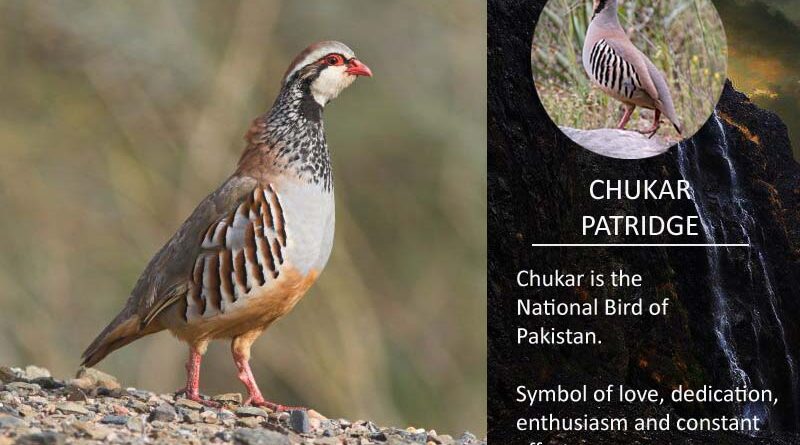Chukar Partridge – The National Bird of Pakistan
Chukar Partridge
Chukar Partridge is the national bird of Pakistan. The Chukar found mostly in New Zealand and other European countries. Its native habitat is Pakistan, Kashmir, India and Afghanistan. It is closely related and resembles its western equivalent, the red-toed caterpillar, the Electors rufa. Choker is a 32-35 cm long bird, with a light brown waist, grey breasts and a leather belly. The face is white with a black face. It has striped stripes and red legs. When disturbed, it prefers to run rather than fly, but if needed, it flies a short distance on round wings. Bran prefers rocky, steep and open hills. Bran is a dry, open, and often mountainous country.
In the wild, the squirrels travel in groups of 5-40 birds called crows. It has a nest on the scanlap line where 8 to 20 eggs are laid. Bran will be insecure to eat a variety of seeds and some insects. When in captivity, they will lay 1 egg a day during the breeding season if the eggs are collected daily. For predators, the squirrel is a very difficult bird because of its surgical upward flight and sudden disappearance in the bushes.
Pakistan is home to some of the world’s rarest and most unique birds due to its diverse climate and diverse terrain. Its wetlands and lakes attract millions of migratory birds from around the world each year, especially to Siberia, which are in their natural habitat in the forests and mountains, in addition to their native birds. Provide a great opportunity for bird watchers around the world. The government has set up many bird sanctuaries that allow local and migratory birds to thrive. Hunters are only allowed to hunt with a permit or license during the hunting season.
Chukar Food
Like most birds, bran is a vegetarian and eats mostly leaves, insects and seeds, especially sunflower, mustard and pine pine seeds. Sage brush is another important component of the diet of bran found in North America.
Significance and Cultural Of Chukars
The squirrel is the national bird of Pakistan and is considered a symbol of good luck in its native culture. In Pakistan, the word Chukar is derived from the Sanskrit word Chukar which means intense love. In Pakistan and India, the word chukar is often used to refer to a loved one. The Indian mythology, Chukars are considered to be in love with the moon and are mostly found looking at the moon.
Chukar Behavior
The Chukar Part is considered to be a very difficult bird in terms of its behavior. The chokers usually move in groups and when they are alone, they mostly run instead of flying. In the wild, chokers fly in groups of 40-40 birds, especially in winter. Chicks are individual animals and birds and are responsible for protecting their young during the male breed.
Chokers have an unusual ability to pose a threat and have a clear sound of danger on the ground and in the air. For hunters, Ch is one of the most difficult birds to hunt, hence the name Game bird. Squirrels have the ability to take fast flights and can disappear into the bushes in seconds. They are considered difficult to hunt without dogs. Bullet Tarant, a desert survivor, wrote in his article to a desert hunter, “A few hunters are twice as big as pigs, and those who are three times as famous.”
Due to their exotic and challenging nature, chicks are reared especially for hunting in some parts of Pakistan and yet they are considered illegal by the Pakistani authorities. June and July are considered hunting seasons in Pakistan and Afghanistan.
Facts about Pakistan’s National Bird
- Common Name: Chukar
- Scientific name: Alectoris chukar
- Kingdom: Animalia
- Phylum: Chordata
- Class: Aves
- Order: Galliformes
- Family: Phasiianidae
- Genus: Alectoris
- Species: A. Chukar
- Found in: Pakistan to Afghanistan
- Habitat: prefer rocky, steep, and open hillsides
- Average Length: 34–38 cm;
- Average Weight: Male 540–766 g; female 366-537g
- Average Lifespan: 2-6 years in wild
- Average Speed: 20.1 km/h
Click Here for more info :



